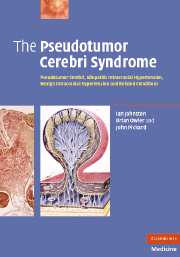 The Pseudotumor Cerebri Syndrome
The Pseudotumor Cerebri Syndrome Published online by Cambridge University Press: 21 August 2009
Introduction
The treatment of PTCS is a somewhat complex matter although, in clinical terms, it might be described as relatively successful. In any analysis of the treatment of PTCS there are at least five aspects reflecting this complexity which need to be considered.
PTCS is a condition of quite variable natural history with cases ranging from those which resolve spontaneously or rapidly with either correction/withdrawal of an apparent causative factor, or with brief and simple treatment, to those cases that are chronic, progressive and refractory to treatment.
There are no methodologically satisfactory studies of the different treatment options. Thus, in a 2002 report reviewing ‘interventions for idiopathic intracranial hypertension’, Lueck and McIlwaine drew the following conclusion: ‘There is insufficient information to generate an evidence-based management strategy for IIH. Of the various treatments available, there is inadequate information regarding which are truly beneficial and which are potentially harmful. Properly designed and executed trials are needed.’
The majority of treatments used over the past 100 years have all been successful, at least to a significant degree, and in a significant number of cases. The historical development of treatment methods is considered in detail in Chapter 2, but in summary these are serial lumbar punctures, subtemporal decompression, steroids, diuretics, acetazolamide, CSF shunting, optic nerve sheath decompression and direct treatment of cranial venous outflow obstruction. All are still in use and the choice of which to use in a particular patient often comes down to the desire to avoid a particular complication, or the specialty of the treating doctor. All, however, have a significant failure rate or complication rate, or, indeed, both.
[…]
To save this book to your Kindle, first ensure no-reply@cambridge.org is added to your Approved Personal Document E-mail List under your Personal Document Settings on the Manage Your Content and Devices page of your Amazon account. Then enter the ‘name’ part of your Kindle email address below. Find out more about saving to your Kindle.
Note you can select to save to either the @free.kindle.com or @kindle.com variations. ‘@free.kindle.com’ emails are free but can only be saved to your device when it is connected to wi-fi. ‘@kindle.com’ emails can be delivered even when you are not connected to wi-fi, but note that service fees apply.
Find out more about the Kindle Personal Document Service.
To save content items to your account, please confirm that you agree to abide by our usage policies. If this is the first time you use this feature, you will be asked to authorise Cambridge Core to connect with your account. Find out more about saving content to Dropbox.
To save content items to your account, please confirm that you agree to abide by our usage policies. If this is the first time you use this feature, you will be asked to authorise Cambridge Core to connect with your account. Find out more about saving content to Google Drive.